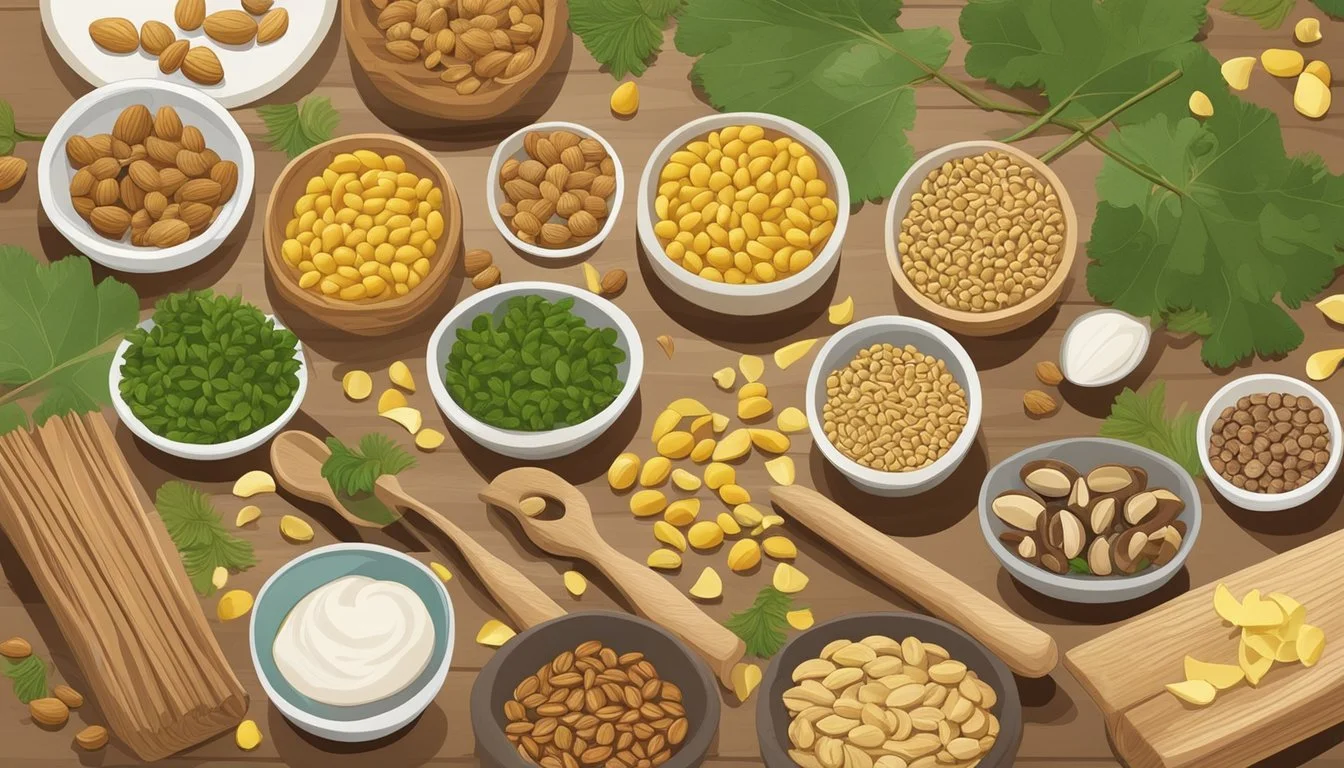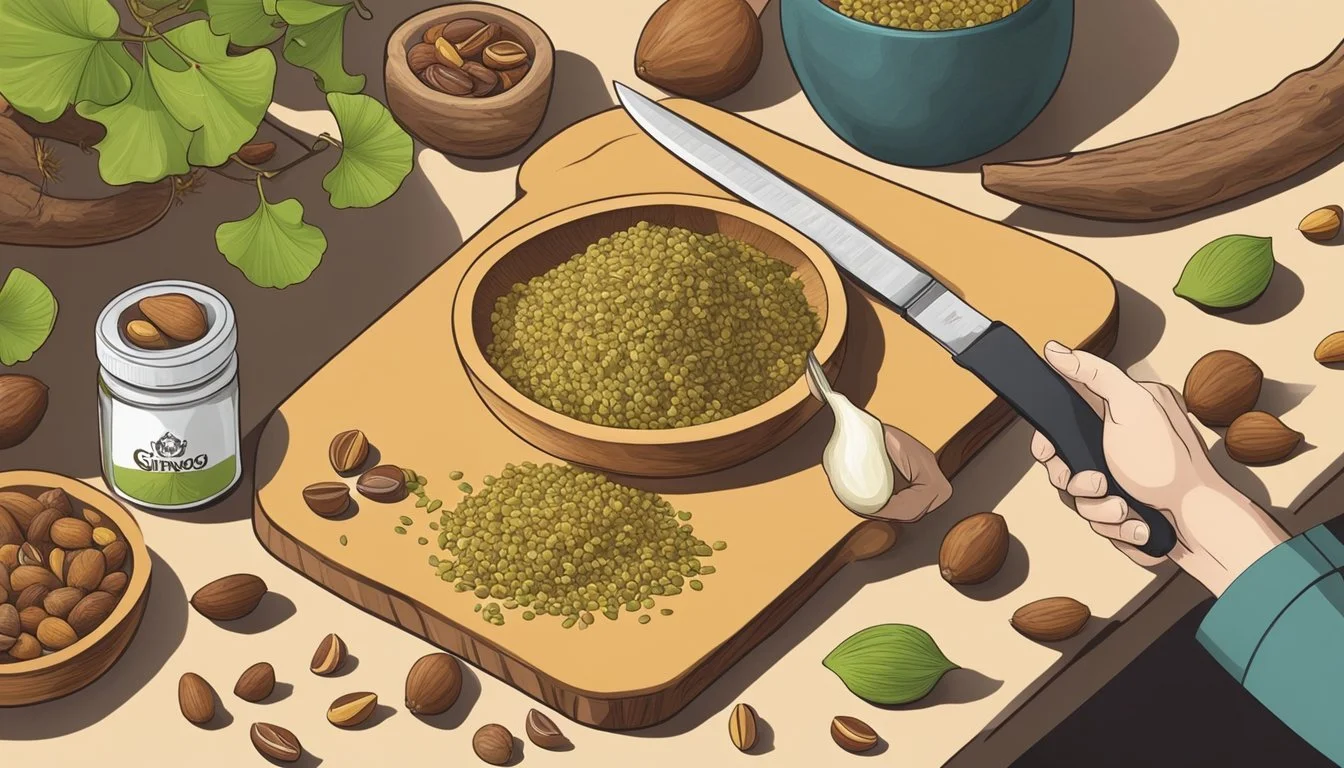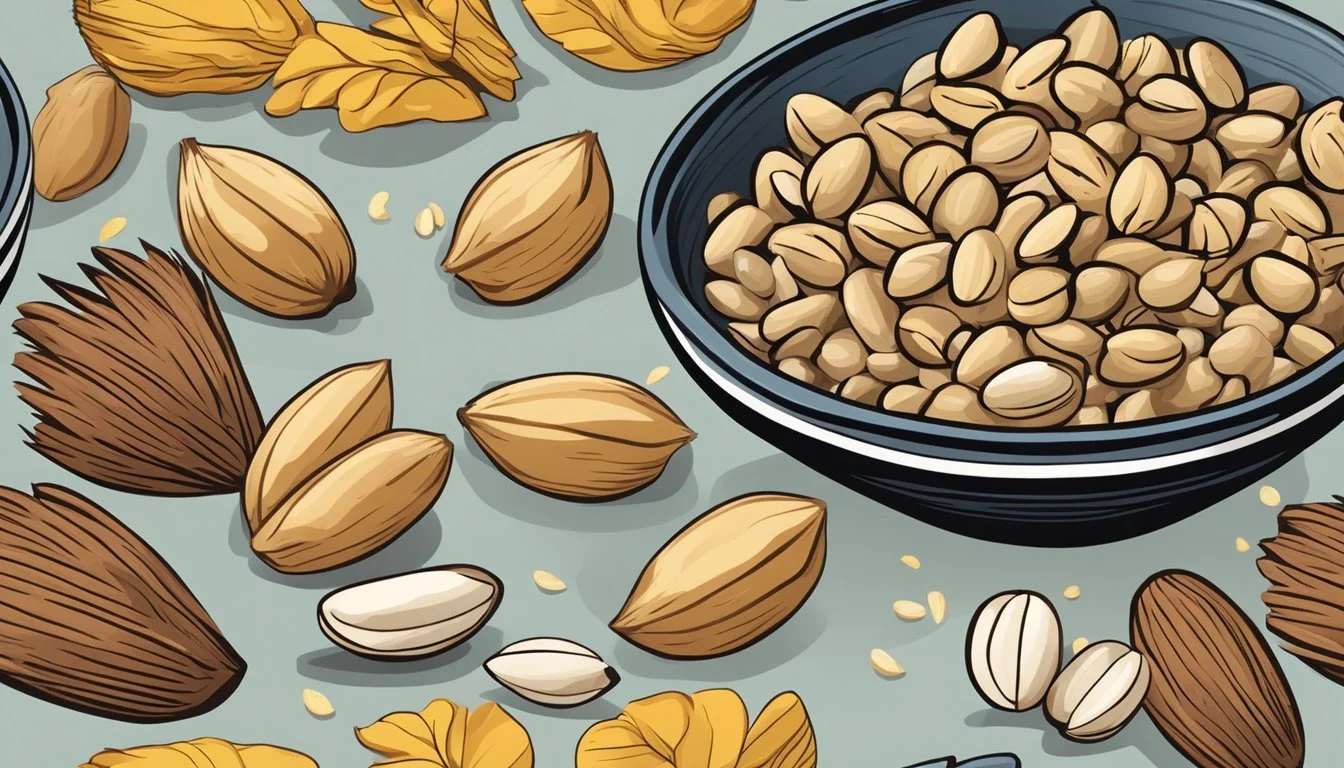Ginkgo Nut Substitutes
Top Alternatives for Cooking and Baking
Ginkgo nuts, derived from the ancient ginkgo biloba tree, are prized for their unique flavor and texture in culinary applications. While these nuts can add a distinctive element to a variety of dishes, they are not always readily available or suitable for everyone's palate or dietary restrictions. Finding the right substitute for ginkgo nuts requires considering the nut's dual qualities of tenderness and a delightful bite.
The key to a successful substitute lies in mimicking these textural components and the subtle taste profile. Edible options such as soybeans or roasted grains like barley or wheat berries could provide a similar mouthfeel to ginkgo nuts. Additionally, when replacing ginkgo nuts in a recipe, it is important to balance the flavors to complement the other ingredients while ensuring the alternative choice harmonizes with the overall dish.
Given the mild toxicity of raw ginkgo nuts, it is crucial for substitutes to be safe for consumption while also keeping the integrity of the intended dish. Seasoning and preparation methods are adjusted accordingly to enhance the substitute's flavor, emulating that of cooked ginkgo nuts. By doing so, the culinary experience can still be enjoyed without compromising safety or taste.
Origins and Characteristics of Ginkgo Nuts
The ginkgo tree, with its distinctive fan-shaped leaves, produces seeds commonly known as ginkgo nuts. These nuts have been integral to East Asian cuisines and traditional medicine for centuries, with a unique texture and flavor that make them both a culinary ingredient and a topic of cultural interest.
Cultural Significance in East Asia
Ginkgo trees have deep roots in the history and traditions of China and Japan, where they are revered for their longevity and resilience. Revered as a symbol of hope and peace, ginkgo trees have survived historical events and are often found in temple gardens and public spaces. Ginkgo nuts themselves are considered a delicacy and are traditionally used in festive dishes, especially during special occasions such as weddings and the Chinese New Year.
Culinary Uses of Ginkgo Nuts
When it comes to cuisine, ginkgo nuts are valued for their nutritional properties and their role in various dishes. They are typically roasted or boiled to soften their texture and are used in preparations like congee, savory puddings, or as an accompaniment to meats and other vegetables. Despite the pungent odor of the ginkgo fruits, which contain the nuts, the seeds themselves impart a subtle flavor esteemed in many East Asian recipes.
Physical and Sensory Properties
Texture: Once cooked, ginkgo nuts have a soft, chewy texture comparable to that of edamame or chestnuts.
Flavor: They possess a mild, slightly bitter taste with a delicate, nutty flavor.
Shell: The outer hard shell, or the sarcotesta, is cracked to reveal the edible seed within.
Skin: The skin of the kernel, another layer underneath the shell, is removed before consumption as it can be bitter.
Odor: The fruits that encase the nuts emit a strong, disagreeable smell due to butyric acid; this is not indicative of the seeds' quality.
Nutritional Profile of Ginkgo Nuts
Ginkgo nuts, the edible seeds of the Ginkgo biloba tree, contain a unique nutrient composition that sets them apart from other nuts. Noted for both their health benefits and potential risks, these nuts are a subject of interest for their nutritional content and the presence of ginkgotoxin.
Health Benefits
Ginkgo nuts are esteemed for their rich array of phytonutrients and antioxidants. They offer a notable content of Vitamin B3 (niacin) and Vitamin C, as well as a mix of beneficial compounds:
Flavonoids: Antioxidants that assist in protecting the body against cellular damage.
Terpenoids: Known for their anti-inflammatory properties.
These antioxidants are instrumental in influencing gene expression and may provide an armor against cancer-causing agents.
Potential Risks and Toxins
While ginkgo nuts can be a nutritious addition to a diet, they must be consumed with caution. They contain ginkgotoxin, also known as 4'-O-methylpyridoxine, which can act as a neurotoxin:
Ginkgotoxin: Consuming large quantities of ginkgo nuts may lead to poisoning, as ginkgotoxin interferes with vitamin B6 functions.
It is advised that ginkgo nuts should be eaten in limited amounts to mitigate the risk of ginkgotoxin-related health issues. As each nut offers both benefits and risks, consumers should be well-informed about proper preparation methods to reduce the presence of toxins.
Safe Handling and Preparation
When preparing Ginkgo nuts, one must be aware of the risk of toxins that can cause adverse reactions and the proper culinary techniques to ensure they are safe to eat.
Avoiding Ginkgo Poisoning
Ginkgo nuts, especially those foraged from female ginkgo trees, require careful handling due to the presence of toxic substances. The raw fruit pulp contains urushiol, the same irritant found in poison ivy, capable of causing contact dermatitis or an allergic reaction in sensitive individuals.
Key precautions:
Wear gloves during handling and cleaning to prevent skin contact with toxic substances.
Clean thoroughly by removing the outer flesh, which may carry the majority of the irritants.
Boiling the nuts can help to break down and remove remaining toxins; typically, it is recommended to boil them in water for at least 10 minutes.
Culinary Techniques
Cooking Ginkgo nuts properly not only enhances their flavor but also ensures they are safe to consume. Cleaning, boiling, and roasting are techniques commonly used.
Proper processing:
Clean: Rinse the nuts to remove any residue.
Boil: After cleaning the nuts, boil them to reduce harmful components.
Roast: Finally, roast the Ginkgo nuts at 350°F (about 175°C) for 15 minutes to develop their distinctive flavor and texture.
Remember that the shells are not as tough as other nuts, so gentle cracking is sufficient to obtain the edible kernel inside. Avoid excessive force that can smash the nut meats, and consider shelling them between layers of cloth for cleanliness and safety.
Finding and Foraging for Ginkgo
Foraging for ginkgo nuts is a rewarding endeavor for urban foragers and lovers of these unique kernels. Careful identification of ginkgo trees and proper techniques in harvesting ensure the best quality nuts for culinary use.
Identifying Ginkgo Trees
Ginkgo trees (Ginkgo biloba) are native to China but are commonly found in urban areas of Brooklyn and other cities around the world, including Japan. They have distinct fan-shaped leaves, which turn a vibrant yellow in the fall. Identifying features include:
Height: Typically 20-40 ft in urban settings, can grow up to 100 ft.
Leaves: Unique fan shape with a split in the center.
Habitat: Often found along city streets and in urban and suburban parks.
Harvesting and Storing Nuts
Foragers should time their harvest in the autumn when the ginkgo nuts are ripe. The nuts are encased in a fleshy, orange pulp that has an unpleasant odor, which must be removed before consumption. Steps include:
Collection: Gather nuts from the ground where they fall naturally.
Cleaning: Remove the smelly pulp and wash the nuts thoroughly.
Storage: Ginkgo nuts can be stored briefly at room temperature, but for long-term storage, it's best to keep them refrigerated or frozen to preserve their quality. It's important to ensure they're properly sealed to avoid odor transfer.
Common Ginkgo Nut Substitutes
When cooking with Ginkgo nuts, one may encounter their distinct taste and texture, which isn't always easy to mimic. However, certain nuts and ingredients can serve as substitutes, whether for their similar flavor profiles or their role in a recipe.
Nuts Similar in Flavor and Texture
Pistachios: Offering a somewhat similar taste, pistachios can be used as a substitute for Ginkgo nuts. Their delicate flavor doesn't overwhelm dishes and provides a comparable bite.
Pine Nuts: Known for their buttery texture and nutty taste, pine nuts can mimic the softness of cooked Ginkgo nuts.
Alternative Ingredients for Recipes
Roasted Chestnuts: With a soft, starchy texture, roasted chestnuts can replace Ginkgo nuts in recipes, especially for purees and confectioneries.
Almonds: Blanched and chopped almonds can be an alternative, offering a subtle sweetness and crunch.
Pecans: For a rich, buttery flavor that enhances sweets and savories, pecans can be employed as a stand-in.
Cashews: Their creamy texture and mild taste make cashews a suitable substitute in both sweet and savory dishes.
Incorporating Substitutes into Dishes
In selecting substitutes for ginkgo nuts in recipes, one should consider how the replacement will affect both the texture and flavor of the dish.
Substituting Ginkgo Nuts in Baking
When it comes to baking, substitutes for ginkgo nuts need to complement the texture and taste profile of the baked goods. For example, granola often calls for nuts to add a crunch, and similarly, a crispy texture can be replicated using:
Raisins: Add sweetness and a chewy texture, suitable for bread and scones.
Dried Apricots or Figs: Offer a sweeter taste and can be finely chopped, a good fit for cakes and tarts.
Rice Cereal: Crushed rice cereal mimics the crunch of nuts well and can be integrated into cookies or bars.
One should adjust the quantity of these substitutes to taste, as they can alter the sweetness and consistency of the bake.
Using Substitutes in Savory Recipes
In savory cooking, the aim is to emulate the tender but firm texture of ginkgo nuts. For salads and other recipes requiring a nut-like bite, one can consider:
Soybeans: Their tender quality and bite make them a good stand-in for ginkgo nuts.
Roasted Barley/Wheat Berry: These grains provide a similar chewiness and can be included in soups and salad toppings.
These alternatives should be prepared similarly to how one would prepare ginkgo nuts, such as boiling or roasting before inclusion in the final dish.
Allergies and Sensitivities
In addressing allergies and sensitivities related to ginkgo nuts, it is essential to understand the common allergic reactions and the specific considerations for those with nut allergies. Potential symptoms and mitigation strategies should be recognized for their role in maintaining safety.
Recognizing and Mitigating Symptoms
Allergic reactions to ginkgo can include skin irritations such as contact dermatitis or more severe responses akin to other tree nut allergies. Ginkgo poisoning, while different from an allergic reaction, can manifest in gastrointestinal distress if raw or improperly prepared ginkgo nuts are consumed. To manage these risks, individuals should:
Identify potential symptoms: skin rash, itching, gastrointestinal upset.
Seek immediate medical attention for signs of a severe allergic reaction, such as difficulty breathing and swelling of the mouth or throat.
Handle ginkgo with care if skin sensitivity is known, wearing gloves to mitigate contact dermatitis.
Nut Allergy Considerations
As ginkgo nuts fall within a unique category, they may not cross-react with common tree nuts. However, reports suggest that ginkgo pollen allergens may be inhibited by other tree and weed pollens, indicating a potential for cross-reactivity.
For those with nut allergies, it is recommended to:
Consult with an allergist before consuming ginkgo, especially if allergic to tree nuts.
Be aware of cross-reactivity: While not definitive, some pollens inhibited ginkgo pollen allergens in lab tests, hinting at potential sensitivity for those allergic to substances like oak, ryegrass, mugwort, and ragweed.
Proper identification and avoidance of allergens, coupled with an actionable emergency plan, greatly contribute to the effective management of allergies and sensitivities to ginkgo nuts.
Botanical Information
The botanical intricacies of Ginkgo biloba, commonly known as the gingko tree, provide insight into its unique reproductive life cycle, featuring separate male and female trees, and its ornamental charm.
Botany of the Ginkgo Tree
Ginkgo biloba is the sole survivor of the Ginkgophyta division and is often referred to as a "living fossil" as it is the only remaining member of a group of ancient plants that once dominated the earth. The Ginkgo tree has distinctively fan-shaped, bright green leaves that turn a brilliant yellow in the fall, adding to its reputation as an essential and beautiful ornamental tree.
Male Ginkgo Trees:
Do not produce fruit.
Pollen-producing, with small, catkin-like flowers.
Female Ginkgo Trees:
Bear the fruit-like seeds.
Seeds are encased in a fleshy outer layer, which can emit a strong, disagreeable odor when decomposing.
The Life Cycle of Ginkgo Trees
The Ginkgo tree has a fascinating life cycle that begins with the dispersal of seeds from the female tree. These seeds must go through a period of stratification, typically requiring exposure to cold temperatures, to successfully germinate. Once germinated, the ginkgo seed develops into a slow-growing tree that can live for hundreds, if not thousands, of years.
Stages:
Seed Dispersal: Primarily from female trees.
Germination: Affected by environmental factors like temperature.
Growth: Characterized by its longevity and tolerance to environmental stress.
Reproduction: Entails the production of motile sperm in the male trees—an exceptional trait among modern seed plants—and the eventual fertilization of ovules in the female trees.
Environmental Impact and Sustainability
This section explores the cultivation of ginkgo trees and their influence on local ecosystems, examining both the positive and negative aspects in terms of environmental sustainability.
Ginkgo Tree Cultivation
Ginkgo biloba, a tree with prehistoric roots, is lauded for its resilience and minimal requirements during cultivation. These trees thrive in varied environmental conditions without extensive use of pesticides. In terms of sustainability, ginkgo trees are advantageous as they are long-lived and can contribute to carbon sequestration over their extended lifespans. The act of planting ginkgo has limited adverse environmental impact, as these trees generally require less water and intervention compared to some agricultural crops.
Water Use: Modest, making it relatively sustainable in areas with water scarcity concerns.
Chemical Use: Typically low, as ginkgo trees are not heavily reliant on synthetic pesticides.
Impact on Local Ecosystems
The presence of ginkgo trees in local environments can be both beneficial and challenging. Their hardy nature allows them to function as erosion barriers, which is invaluable in preserving soil health and preventing water runoff. However, the seeds produced by female ginkgo trees contain alkylphenols, which can be toxic and allergenic. When ginkgo seeds fall and decompose, these compounds enter the surrounding ecosystem, potentially impacting soil composition and local flora and fauna.
Erosion Control: Ginkgo biloba demonstrates an ability to stabilize soil and reduce erosion.
Soil Health: While the trees can positively influence soil structure, seed decomposition can introduce toxins.
It should be noted that cultivation strategies, such as selective planting of male trees, can mitigate some negative impacts.
Cultural and Historical Significance
The Ginkgo tree, specifically Ginkgo biloba, is deeply connected to various aspects of East Asian cultures, holding notable places in traditional medicine and symbolic interpretation.
Ginkgo in Traditional Medicine
In China, ginkgo nuts have been utilized for their medicinal properties for centuries. They were traditionally considered an aid for lung functions and were often used to alleviate symptoms associated with asthma and coughs. Ginkgo biloba also gained recognition for its potential as an aphrodisiac and for improving circulatory problems.
China: Traditional use of ginkgo nuts in respiratory treatments and as a natural aphrodisiac.
Therapeutic properties: Believed to include improvements in blood flow and respiratory functions.
Symbolism of the Ginkgo Tree
The history of the ginkgo tree dates back over 200 million years, earning it the moniker "living fossil." In Japan and China, the ginkgo biloba tree stands as a symbol of resilience and longevity. The unchanging nature of the tree over millennia has contributed to its spiritual veneration.
Longevity: The ginkgo is often planted near temples and is revered for its age and vitality.
Resilience: Symbolizes the ability to withstand the test of time, both culturally and biologically.
Creative Uses in Modern Cuisine
Ginkgo nuts are being embraced by chefs for their unique flavor and texture, paving the way for culinary innovation. They are at the heart of a number of modern dishes that draw from both traditional uses and contemporary fusion trends.
Innovative Ginkgo Nut Recipes
Ginkgo nuts enhance a dish's depth with their distinctive flavor profile which can be soft and tender or carry a slight bite. Their utility in modern cuisine extends to both sweet and savory dishes:
Savory Creations: Chefs incorporate ginkgo nuts into rich broths or alongside meats, where their tender texture contrasts with denser ingredients.
Sweet Innovations: They can also be a subtle addition to desserts, perhaps ground into a paste and used in fillings for pastries, adding a nuanced, slightly bitter taste.
Fusion Dishes and Global Influence
The fusion of ginkgo nuts into diverse culinary traditions highlights their global influence. They are often used as a bridge between Eastern and Western cuisines:
Asian Fusion: Ginkgo nuts are paired with soybeans or grains like barley to create dishes that meld traditional Asian tastes with Western textures and cooking techniques.
Cross-Cultural Appetizers: They might feature in tapas or small plates, complementing or standing in for nuts like Marcona almonds, to surprise diners with a burst of unexpected but pleasing flavor.
By integrating ginkgo nuts into their offerings, chefs worldwide continue to push the boundaries of traditional recipes with bold and innovative gastronomic choices.
Handling Legal and Trade Aspects
When dealing with ginkgo nuts, entities must be aware of the specific legal frameworks and trade protocols that impact their market flow and economic significance.
Regulations on Ginkgo Nuts
Ginkgo nuts, although less common allergens, are subject to food safety regulations due to potential risks of poisoning if consumed in large quantities or if prepared improperly. It is crucial that traders and consumers comply with the Food Allergen Labeling and Consumer Protection Act (FALCPA), which mandates the disclosure of certain tree nuts on labels.
Food Allergen Labeling: Ginkgo nuts must be correctly labeled to ensure that consumers are informed of their presence in products.
Safety Protocols: Preparatory methods are regulated to prevent the occurrence of ginkgo poisoning, with recommendations for proper handling and cooking.
Import and Export Considerations
The trade of ginkgo nuts involves navigating through import and export laws that vary by country, which could influence their accessibility and price in the market.
Import Regulations: Countries may have specific import controls for ginkgo nuts to monitor food safety, which could include restrictions or required certifications.
Export Protocols: Exporters must adhere to international trade agreements and local regulations, which dictate how ginkgo nuts can be transported and sold abroad.
The economic impact of these regulatory dynamics plays a significant role in the global availability and cost of ginkgo nuts. Trade parties are advised to remain well-informed about the latest legal changes to maintain compliance and ensure smooth operations.













